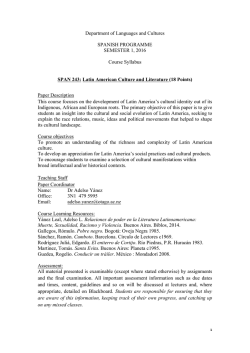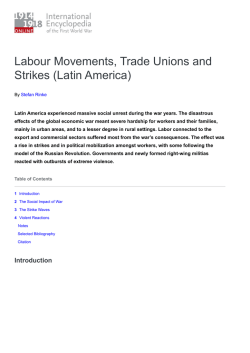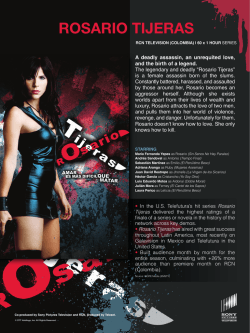
two cases of pregnancy- and lactation
Rev. Méd. Rosario 82: 112-113, 2016 RESÚMENES DE PUBLICACIONES TWO CASES OF PREGNANCY- AND LACTATION-ASSOCIATED OSTEOPOROSIS SUCCESSFULLY TREATED WITH DENOSUMAB Ariel Sánchez,(1) María Belén Zanchetta,(2) Karina Danilowicz.(3) 1) Centro de Endocrinología, Rosario, Argentina; 2) IDIM Instituto de Investigaciones Metabólicas, Buenos Aires, Argentina; 3) Hospital de Clínicas, Buenos Aires, Argentina. Abstract Case 1: A 35-year old woman in the 8thmonth of her first pregnancy suffered acute lumbar pain that persisted for 4 months. In the 5th month postpartum an acute increase in the low back pain led to a MRI which showed recent deformity in L1 and deformities of undetermined time of evolution in L2, L4, and L5. Laboratory evaluation did not reveal metabolic derangements. She had low bone mineral density (BMD, DXA) and severe deterioration of the microarchitecture of distal appendicular bone (HRpQCT). Kyphoplasty of all 4 vertebrae was performed in 2 stages, and treatment with subcutaneous denosumab, 60 mg every 6 months, was begun. There was rapid and almost complete improvement in pain. An increase in trabecular bone was documented with HR-pQCT. 112 Case 2: A 33-year old mother who was breastfeeding her first-born child experimented acute dorsal pain. RMI revealed partial compression fractures in vertebrae D5-7. Her axial BMD was low. There was no family history of osteoporosis, and causes of secondary osteoporosis were ruled out. Her pain slowly subsided with conservative measures, oral analgesics, and nasal calcitonin. Then, treatment with oral strontium ranelate was prescribed; after 3 months serum alkaline phosphatase and osteocalcin had not increased, and after one year lumbar bone mineral density (BMD) was unchanged. Treatment was switched to subcutaneous denosumab. After one year, lumbar BMD had increased 14%, and the pain had almost completely subsided. Clin Cases Bone Miner Metab 2016 (en prensa) REVISTA MÉDICA DE ROSARIO Resúmenes de Publicaciones EFFECT OF DENOSUMAB ON BONE MINERAL DENSITY AND MARKERS OF BONE TURNOVER AMONG POSTMENOPAUSAL WOMEN WITH OSTEOPOROSIS Sánchez A,1 Brun LR,2 Salerni H,3 Costanzo P,3 González D,4 Bagur A,4 Oliveri B,4,5 Zanchetta MB,6 Farías V,6 Maffei L,7 Premrou V,7 Mansur JL,8 Larroudé MS,9 Sarli MA,6 Rey P,6 Ulla MR,10 Pavlove MM,11 Karlsbrum S,11 Brance ML.12 Grupo Argentino de Estudio de la Osteoporosis. 1) Centro de Endocrinología, Rosario. 2) Laboratorio de Biología Ósea, Facultad de Ciencias Médicas, Universidad Nacional de Rosario. 3) Consultorios de Investigación Clínica Endocrinológica y del Metabolismo Óseo (CICEMO), Buenos Aires. 4) Mautalen Salud e Investigación, Buenos Aires. 5) Laboratorio Osteoporosis y Enfermedades Metabólicas Óseas, INIGEM, UBA-CONICET, Hospital de Clínicas, Buenos Aires. 6) Instituto de Investigaciones Metabólicas Dr. Zanchetta, Buenos Aires. 7) Consultorios Asociados de Endocrinología Dra. Laura Maffei, Buenos Aires. 8) Centro de Endocrinología y Osteoporosis, La Plata. 9) Hospital Milstein, Buenos Aires. 10) Centro de Endocrinología y Osteopatías Médicas, Córdoba. 11) Hospital Durand, Buenos Aires. 12) Centro de Reumatología, Rosario. The aim of this study was to evaluate the effect of denosumab (Dmab) on bone mineral density (BMD) and bone turnover markers after 1 year of treatment. Additionally, the effect of Dmab in bisphosphonatenaïve patients (BP-naïve) compared to patients previously treated with bisphosphonates (BP-prior) was analyzed. This retrospective study included 425 postmenopausal women treated with Dmab for 1 year in clinical practice conditions in specialized centers from Argentina. Participants were divided according to previous bisphosphonate treatment in BP-naïve and BP-prior. A control group of patients treated with BP not switched to Dmab matched by sex, age and body mass index was used. Data are expressed as mean±SEM. After 1 year of treatment with Dmab the bone formation markers total alkaline phosphatase REVISTA MÉDICA DE ROSARIO and osteocalcin were significantly decreased (23.36% and 43.97%, respectively), as was the bone resorption marker s-CTX (69.61%). Significant increases in BMD were observed at the lumbar spine, femoral neck and total hip without differences between BP-naïve and BPprior. A better BMD response was found in BP-prior group compared with BP treated patients not switched to Dmab. Conclusion: Dmab treatment increased BMD and decreased bone turnover markers in the whole group, with similar response in BP-naïve and BP-prior patients. A better BMD response in BP-prior patients versus BP treated patients not switched to Dmab was observed. J Osteoporos 2016 (en prensa) 113
© Copyright 2025




